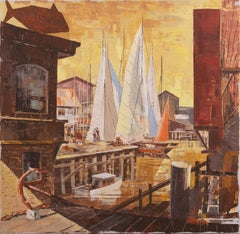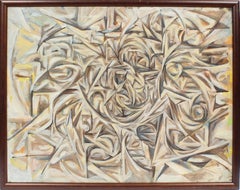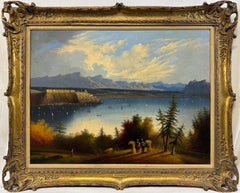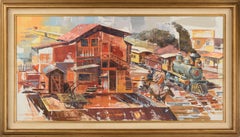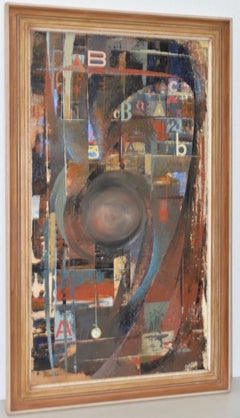Jack Wilson Art
Jack Wilson was born in Sausalito and educated in San Francisco, he lived for many years in Los Gatos, until he died in 1988. Wilson’s style was to paint with knives that he made himself. Besides producing pieces that have hung in different local banks and international consulate offices, Wilson also provided illustrations for a 1968 land-use study that was conducted by the Lexington Hill Association and which was about development near the Lexington Reservoir. He loved painting maritime life as he observed it along the California coast, and his frequent subjects were seagulls, fishing boats and beachfront. But he also found inspiration in town, and over the years, his work appeared in different places in Los Gatos. In 1987, for example, he painted an 1890s railroad depot, which was used as the cover for the GTE telephone book for Los Gatos that year. A librarian from Los Gatos, Paul Kopach and some of Wilson’s friends had embarked on a project to digitize photographs of the artist’s work and put them online with some background information. The library had acquired the donated collection when Wilson’s friends turned it over to staff members, asking if there was a way of preserving the work. The art was destined for the garbage dump when a caretaker threw out boxes of his work when she was helping Wilson’s widow, Meta, move from Villa Vasona. An astute maintenance worker at Villa Vasona found the boxes and saved them. Marge Faucher, an artist who belonged to the same art guilds that Wilson was a part of, felt that the work is worth preserving because of his local ties. “He won many awards, and his style is distinctive,” Faucher said. Wilson’s style was to paint with knives that he made himself. As part of the collection handed over to the library, there are old newspaper clippings that promoted his exhibitions, letters from those who appreciated his art and various examples of his work. Faucher and Joyce Louden, a friend of Wilson’s wife, moved the preservation project along. They have done an inventory of everything they have found and are matching up photographs of the paintings with their titles. Louden herself was not familiar with Wilson before the boxes were found, but she felt that his talent is evident, and his name should be saved from obscurity. “I had never heard of Jack Wilson, but he did wonderful things,” she said. “We want to put the work online for the world to appreciate.”
(Biography provided by Robert Azensky Fine Art)
1960s Jack Wilson Art
Canvas, Oil
1960s Modern Jack Wilson Art
Canvas, Oil
1850s Hudson River School Jack Wilson Art
Canvas, Oil
20th Century English School Jack Wilson Art
Canvas, Oil
1960s Outsider Art Jack Wilson Art
Canvas, Oil
2010s Contemporary Jack Wilson Art
Canvas, Oil
1970s American Modern Jack Wilson Art
Oil, Canvas
21st Century and Contemporary Contemporary Jack Wilson Art
Canvas, Linen, Oil
2010s Contemporary Jack Wilson Art
Canvas, Oil
2010s Contemporary Jack Wilson Art
Canvas, Oil
2010s Abstract Jack Wilson Art
Canvas, Oil, Board
1940s American Modern Jack Wilson Art
Canvas, Oil
19th Century Realist Jack Wilson Art
Canvas, Oil
Late 20th Century American Impressionist Jack Wilson Art
Oil, Canvas
Mid-20th Century Abstract Jack Wilson Art
Canvas, Oil
Mid-20th Century Impressionist Jack Wilson Art
Canvas, Oil
Mid-20th Century Impressionist Jack Wilson Art
Oil, Board
1970s American Impressionist Jack Wilson Art
Oil, Fiberboard, Masonite
1970s American Impressionist Jack Wilson Art
Canvas, Oil
